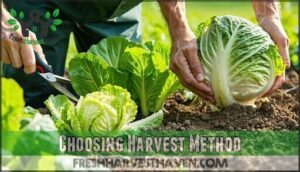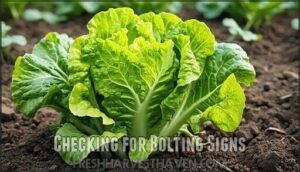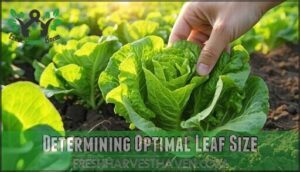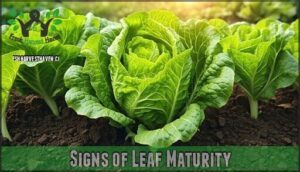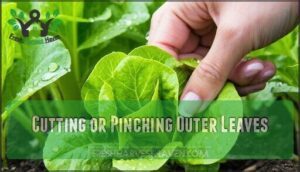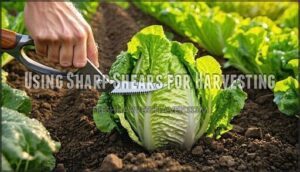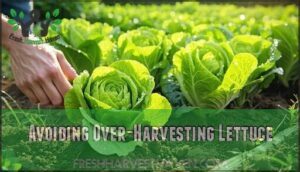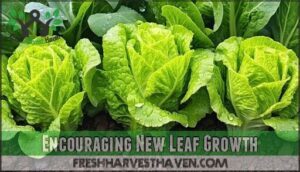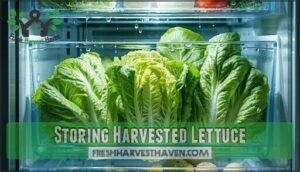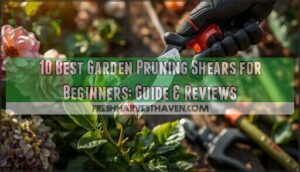This site is supported by our readers. We may earn a commission, at no cost to you, if you purchase through links.
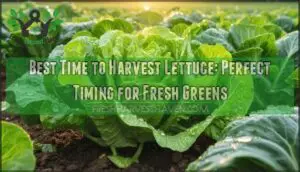
Cool morning temperatures help lettuce retain maximum freshness and crunch. For loose-leaf varieties, you can begin harvesting when plants are just a few inches tall.
Head lettuce needs more patience until heads feel firm and dense. Watch for bolting signs like tall center shoots – that’s your cue to harvest immediately before leaves turn bitter.
The cut-and-come-again method keeps plants producing for weeks, allowing you to enjoy your harvest over an extended period by using this simple yet effective technique to maintain maximum freshness and prevent leaves from becoming bitter.
Table Of Contents
- Key Takeaways
- Harvesting Lettuce Timing
- Choosing Harvest Method
- Identifying Lettuce Readiness
- Harvesting for Continuous Growth
- Storing Harvested Lettuce
- Frequently Asked Questions (FAQs)
- When to harvest leaf lettuce?
- How long does it take to harvest lettuce?
- When should you pick lettuce?
- How long does it take to pick lettuce leaves?
- How do you harvest lettuce in summer?
- What temperature should lettuce be harvested?
- Which month to harvest lettuce?
- Can you let lettuce grow too long?
- What is the best time of day to pick lettuce?
- When to harvest lettuce for the highest yield?
- Conclusion
Key Takeaways
- Harvest in cool morning hours – You’ll get the crispest, most hydrated lettuce when you pick before temperatures rise and cause wilting.
- Look for 4-6 inch outer leaves – You can start harvesting loose-leaf varieties when outer leaves reach this size, typically 30-70 days after planting.
- Use the cut-and-come-again method – You’ll extend your harvest for weeks by cutting only outer leaves while leaving the center crown intact for regrowth.
- Watch for bolting signs – You need to harvest immediately when you see tall center shoots or flowering stalks, as leaves will turn bitter once bolting begins.
Harvesting Lettuce Timing
You’ll know it’s time to harvest your lettuce when the outer leaves reach 3-4 inches long and feel crisp to the touch.
The best window falls between 30-70 days after planting, depending on your variety and growing conditions.
Factors Affecting Harvest Time
Temperature impact drives when you’ll harvest lettuce, determining the perfect window between tender leaves and bitter bolting.
Five key factors influence your timing:
- Variety Maturity – Different cultivars mature from 30-70 days
- Temperature Impact – Cool weather (60-70°F) prevents premature bolting
- Watering Practices – Consistent moisture supports steady growth
- Soil Nutrients – Rich, well-draining soil enhances leaf development
- Sunlight Exposure – Balanced light promotes ideal size without stress
Understanding these influencing factors helps you recognize maturity signs and nail that sweet spot for harvesting lettuce.
Optimal Soil Temperatures
Your soil temperature directly affects when you’ll harvest crisp, tender lettuce. The sweet spot lies between 60-65°F for ideal growth and flavor development.
Cool soil grows sweet lettuce – warm soil triggers bitter bolting.
Here’s how to maintain perfect soil conditions:
- Monitor Germination Temperature Range – Keep soil between 40-85°F for reliable sprouting
- Check Soil pH Impact – Maintain 6.0-7.0 pH levels for nutrient uptake
- Use Mulch Temperature Control – Apply organic mulch to stabilize soil temperature
Cool Weather Growth produces the sweetest leaves, while Hot Weather Effects above 75°F trigger bolting and bitterness. For vigorous growth, nitrogen sidedressing is often essential. Smart soil health management guarantees your lettuce harvest time delivers maximum flavor.
Morning Harvesting Benefits
You’ll get the best lettuce harvest time by picking in the morning when temperatures are cooler.
This timing maximizes your Crispness Advantage and Flavor Intensity while achieving Peak Hydration levels.
Morning harvest prevents Reduced Wilting that occurs during afternoon heat.
Your lettuce maintains superior texture and taste when harvested before the sun intensifies.
Minimal Bolting risk exists during these cooler hours, keeping leaves tender rather than bitter.
When to pick lettuce becomes obvious once you experience the difference morning harvesting makes.
Aspect Morning Harvest Afternoon Harvest
Crispness Advantage
Water Content
Flavor Enhancement
Reduced Wilting
Factors Influencing Leaf Size
While morning brings the crispest leaves, your lettuce’s leaf size depends on several key factors working together.
Smart spacing and consistent care make all the difference in your lettuce harvesting guide. Cut-and-come-again harvesting extends the harvest period.
- Soil Nutrients: Rich, well-fed soil produces larger, more robust leaves for mature lettuce
- Sunlight Exposure: 6+ hours daily light optimizes growth and leaf development
- Watering Practices: Consistent moisture without waterlogging promotes healthy expansion
- Variety Genetics: Some cultivars naturally produce smaller leaves regardless of care
- Plant Spacing: Proper spacing prevents competition, allowing maximum leaf size potential
Choosing Harvest Method
Your harvest method depends on whether you’re growing loose-leaf or head lettuce varieties.
Each type requires a different approach to maximize your yield and keep plants producing fresh greens throughout the growing season.
Cut-and-Come-Again Technique
Master the cut-and-come-again technique for continuous harvest and maximum plant longevity.
This method transforms your lettuce patch into a renewable resource, delivering multiple harvests throughout the growing season.
Technique benefits include:
- Leaf regrowth occurs within days when you cut outer leaves properly
- Harvesting lettuce selectively preserves the plant’s energy reserves
- Picking lettuce leaves from outside-in maintains ideal growth patterns
Always target mature outer leaves on your leaf lettuce, leaving the crown intact for sustained production.
Harvesting Loose-Leaf Lettuce
Loose-leaf varieties offer the perfect harvesting technique for continuous harvest.
When picking lettuce leaves, target outer leaves at 4-6 inches for ideal leaf size and flavor.
This cut and come again method keeps plants producing fresh greens while preventing bolting.
Harvesting lettuce regularly maintains tenderness and sweetness.
Always taste assessment before large harvests – bitter leaves signal it’s time for succession planting to maintain your salad bowl supply.
Harvesting Head Lettuce
When you’re ready to wrap up your head lettuce harvest, check for dense heads that feel firm when gently squeezed.
Cut straight through the core with a sharp knife, leaving about an inch of stem attached. This core cutting method guarantees you get the full harvest without damaging the head’s structure.
To maintain freshness, remember to refrigerate at 32–40°F after harvesting.
- Dense heads with tight, compact leaves signal peak lettuce ripeness and ideal harvesting methods
Tools for Harvesting Lettuce
Sharp garden shears and scissors make clean cuts that heal quickly.
Harvesting knife options include specialized lettuce field knives for thick stems.
Shears vs. knives depends on your lettuce type – shears work well for loose leaves, while knives handle dense heads better.
Harvesting baskets keep greens crisp during collection.
Specialized tools like horticultural snips access tight spaces without damaging nearby plants.
Cleaning tools prevents disease spread between plants.
Regular tool maintenance through sharpening and sanitizing guarantees efficient harvesting lettuce throughout the growing season.
For protection from pests, consider using a floating row cover.
Identifying Lettuce Readiness
You’ll know your lettuce is ready when the outer leaves reach 3-4 inches long and show vibrant color without any yellowing or wilting.
Check for bolting signs like a flowering stalk shooting up from the center, which signals it’s time to harvest immediately before the leaves turn bitter.
Looking for Large Outer Leaves
When harvesting lettuce, you’ll know it’s time by examining the outer leaves for proper size and maturity.
These leaves should measure 4-6 inches long for loose leaf lettuce varieties.
Look for crisp, vibrant leaves without blemishes or yellowing.
Outer Leaf Maturity determines your Harvesting Techniques – pick these first while leaving smaller inner leaves to continue growing, ensuring Continuous Growth and Avoiding Over-Harvesting.
Checking for Bolting Signs
Watch for bolting signs like a central stem shooting upward or flowering stalk development.
Temperature effects above 75°F trigger this shift from leaf to seed production. Bitter leaves result as leaf texture becomes tough and fibrous.
Harvest timing matters—catch bolting early before bitter taste ruins your crop. Harvesting lettuce immediately prevents further quality decline.
Determining Optimal Leaf Size
When checking Leaf Size Indicators, look for outer leaves measuring 4-6 inches—your sweet spot for best time harvest.
Variety Leaf Size matters: loose-leaf types reach Ideal Leaf Length faster than head varieties.
Harvesting Immature Leaves yields tender greens, while waiting too long risks bitterness.
Different plant variety choices and growing conditions affect timing, so monitor leaf size closely.
Perfect harvesting techniques depend on matching size to flavor goals.
Mature leaves should display vibrant color indicators.
Signs of Leaf Maturity
Mature lettuce leaves display distinct readiness signs that make harvesting straightforward. Leaf size should reach 4-6 inches for outer leaves, while color intensity deepens to vibrant green or rich red hues. The best time harvest occurs when you notice these visual cues paired with proper texture changes.
Here are key maturity indicators to watch for:
- Leaf thickness increases noticeably compared to younger, thinner leaves
- Vein prominence becomes more defined and visible throughout the leaf structure
- Leaves feel firm yet tender when gently squeezed between your fingers
- Plant shows consistent growth patterns without signs of bolting or flowering
Understanding these readiness signs helps you determine exactly how to harvest lettuce for maximum flavor. Timing matters because harvesting too early yields undersized leaves, while waiting too long risks bitterness and toughness.
Harvesting for Continuous Growth
You’ll get the most out of your lettuce plants by harvesting the outer leaves regularly rather than waiting for the entire plant to mature.
This "cut and come again" approach keeps your plants producing fresh greens for weeks instead of giving you one big harvest, allowing for a continuous supply of fresh lettuce.
Cutting or Pinching Outer Leaves
Once you’ve identified ready lettuce, proper cutting or pinching of outer leaves becomes your gateway to continuous harvests. The pinching technique works like magic—simply grasp mature outer leaves and twist gently, or use clean fingernails to pinch stems about 1/4 to 1/2 inch from the plant’s base.
This method triggers impressive outer leaf regrowth while protecting the growing crown. Your harvest frequency should match leaf development, typically every few days during peak season. Think of it like giving your lettuce plant a gentle haircut rather than a buzz cut.
Key practices for successful leaf lettuce harvesting:
- Remove only the largest, outermost leaves during each session
- Maintain plant health by leaving at least half the foliage intact
- Consider leaf size impact—harvest when leaves reach 3-4 inches long
- Keep cutting lettuce sessions brief to minimize plant stress
- Target morning hours when leaves contain maximum moisture content
This approach guarantees your harvest continues for weeks rather than ending after one picking, ensuring a successful leaf lettuce harvesting experience with impressive outer leaf regrowth and a gentle haircut method that promotes plant health and continuous growth.
Using Sharp Shears for Harvesting
Sharp shears beat hands for harvesting leaf lettuce—they create clean cuts that heal faster and prevent disease transmission.
Position your blade at a 45-degree angle, cutting ¼ inch above the base.
This cut placement encourages rapid regrowth while maintaining plant health through proper tool maintenance.
For ideal results, consider investing in specialized cutting tools.
| Tool Type | Cut Quality | Regrowth Speed |
|---|---|---|
| Sharp Shears | Clean, precise | Fast (7-10 days) |
| Dull Shears | Ragged, torn | Slow (14+ days) |
| Hands | Crushed stems | Variable |
| Kitchen Scissors | Moderate | Moderate |
Clean your shears between plants—shear sanitation prevents spreading bacterial diseases that can devastate entire lettuce beds.
Avoiding Over-Harvesting Lettuce
Many gardeners make the mistake of harvesting lettuce too aggressively, which stunts plant health and reduces re-growth potential.
When harvesting lettuce, take only one-third of the outer leaves at once, leaving the center crown untouched to avoid root disturbance.
This balanced approach maintains growth support while preventing bitterness from stress.
Proper harvest timing guarantees continuous production without triggering early bolting, maximizing your yield impact throughout the growing season.
Encouraging New Leaf Growth
After proper leaf pruning, your lettuce needs the right conditions to bounce back stronger.
Here’s your roadmap for encouraging robust new growth:
- Crown Health: Cut outer leaves 1/4 inch from the base to protect the growing point
- Nutrient Boost: Apply compost weekly to fuel continuous leaf production
- Watering Strategies: Keep soil consistently moist but not waterlogged
- Light Exposure: Provide morning sun with afternoon shade during warm weather
- Harvesting Leafy Greens: Use the cut and come again method every 7-10 days
This approach keeps your lettuce harvesting productive all season long.
Storing Harvested Lettuce
Once you’ve harvested your fresh lettuce, proper storage becomes essential for maintaining its crisp texture and nutritional value.
You’ll want to handle those tender leaves with care and store them correctly to extend their shelf life and preserve that garden-fresh taste.
Refrigeration and Storage Tips
Once you’ve harvested your lettuce, proper refrigerator storage keeps it crisp for days.
Start with gentle washing methods—rinse leaves under cool water, then pat dry completely.
Storage containers lined with paper towels provide humidity control, preventing moisture retention that causes wilting.
Consider using specialized lettuce containers for ideal preservation.
Perforated bags in your crisper drawer maintain airflow while preserving freshness.
This setup prevents browning and extends shelf life to about a week.
Freezing Lettuce for Later Use
While refrigeration works well for short-term storage, freezing methods offer long-term preservation for surplus lettuce after harvesting.
Best varieties like romaine and butterhead freeze better than iceberg due to lower water content. Blanching necessity isn’t required, but thorough washing and drying prevents texture changes.
Pack leaves in airtight bags, removing excess air to maintain freshness. To prevent freezer burn, make certain you remove all air from the packaging.
Though frozen lettuce loses crispness, nutrient retention remains high, making it perfect for cooked dishes without bitterness or wilting concerns.
Maintaining Lettuce Freshness
After harvesting techniques and postharvest care, maintaining your lettuce’s crispness becomes the next challenge.
Proper storage methods and humidity control will extend shelf life substantially.
Follow these essential freshness guidelines:
- Storage Containers: Use breathable containers with ventilation holes to prevent moisture buildup and spoilage prevention
- Temperature Control: Maintain 32°F–36°F in your refrigerator’s crisper drawer
- Moisture Management: Add paper towels to absorb excess water and prevent bruising prevention
- Air Circulation: Don’t pack leaves tightly—they need breathing room for ideal freshness
These simple steps keep your harvest crisp for days.
Handling and Washing Lettuce
Fresh lettuce deserves careful handling to maximize its shelf life and minimize contamination risks.
Start by rinsing leaves under cold running water, using gentle washing techniques to remove dirt without bruising delicate surfaces.
Pat dry with clean towels or use a salad spinner for quick drying methods that preserve texture.
Handle with care throughout the process—rough treatment damages cell walls and accelerates spoilage.
Your storage preparation directly impacts freshness after harvest.
To ensure the best results, it is crucial to follow these steps carefully and handle the lettuce with care throughout the process, as rough treatment can cause significant damage, and proper storage preparation is key to maintaining crispness.
Frequently Asked Questions (FAQs)
When to harvest leaf lettuce?
You’ll know leaf lettuce is ready when outer leaves reach 4-6 inches long, typically 30-50 days after planting.
Harvest in cool morning hours before leaves wilt, cutting outer leaves first while leaving inner growth intact, this is a complete concept to follow for the best results.
How long does it take to harvest lettuce?
Despite thinking you’ll wait weeks, lettuce grows fast! You can start harvesting loose-leaf varieties in just 30 days, with most types ready within 30-70 days depending on variety.
When should you pick lettuce?
Pick lettuce when outer leaves reach 4-6 inches long, typically 30-70 days after planting.
Harvest in cool morning hours before heat causes wilting, and cut leaves before the plant bolts and turns bitter.
How long does it take to pick lettuce leaves?
Like plucking petals from a daisy, harvesting lettuce leaves takes just seconds per plant.
You’ll spend about 30 seconds cutting outer leaves from each plant using clean scissors, leaving inner growth intact for future harvests.
How do you harvest lettuce in summer?
Harvest lettuce in summer by cutting in early morning when it’s coolest, using shade cloth protection, and choosing heat-tolerant varieties that won’t bolt quickly.
What temperature should lettuce be harvested?
You’ll get the best lettuce quality when harvesting at temperatures between 60°F and 70°F.
Avoid harvesting above 75°F as heat causes bitterness and tough leaves.
Cool morning temperatures produce crisp, sweet lettuce.
Which month to harvest lettuce?
Cool-season gardening’s like timing a perfect dance – you’ll harvest lettuce during spring months (March-May) and fall months (September-November) when temperatures stay between 60-70°F for sweetest, most tender leaves.
Can you let lettuce grow too long?
Yes, you can definitely let lettuce grow too long. When lettuce bolts (sends up flower stalks), it becomes bitter and tough, making it unpalatable for fresh eating, so timing matters.
What is the best time of day to pick lettuce?
Morning’s your golden hour for lettuce picking.
You’ll catch leaves at their crispest when they’re loaded with water from the cool night.
Avoid midday heat – it’ll leave you with wilted, bitter greens that taste like disappointment.
When to harvest lettuce for the highest yield?
Harvest lettuce when outer leaves reach 4-6 inches for loose-leaf varieties, using the cut-and-come-again method.
You’ll maximize yield by harvesting regularly every few days, taking only one-third of each plant at a time.
Conclusion
Mastering the best time to harvest lettuce isn’t rocket science, but timing matters more than sending a telegram in the Wild West.
You’ll enjoy peak flavor and crispness when you harvest during cool morning hours before temperatures rise.
Remember to watch for bolting signs and harvest outer leaves at 4-6 inches for continuous production.
With proper timing and technique, you’ll have fresh, tender lettuce from garden to table every time.

